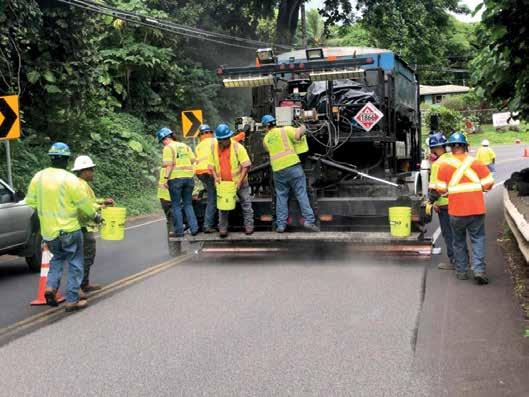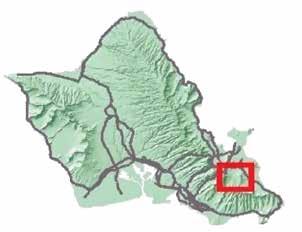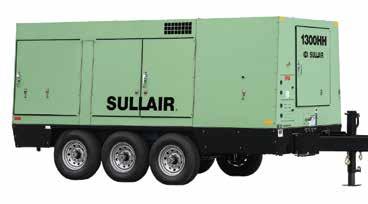
6 minute read
Making the Islands’ Roads Safer
MAKING THE ISLANDS’ ROADS SAFER HDOT tests surface materials on Oahu’s most risky driving areas
Traveling over the 11-mile Pali Highway, drivers make their way across a nearly 90-degree hairpin turn on the Kailua side of two tunnels connecting Honolulu with Oahu’s Windward side. The tight turn, often combined with moisture and gusty winds, is the route for an annual average of 42,000 drivers a day through the Koolau cliffs. These characteristics make the hairpin turn a perfect test site for the Hawaii Department of Transportation Highways Division’s new high-friction surface treatment (HFST). HDOT has also treated three additional test sites along Kamehameha Highway in the Hauula area and roads with heavy moisture and on tight turns.
Advertisement
“We want to increase the friction BY PRISCILLA PÉREZ BILLIG
in the area (Pali Highway) to make sure people have as much control over turns as possible,” says Ed Sniffen, deputy director for HDOT’s Highways Division. “We have signage that warns people of the turns, we have signage that asks them to slow down, advisory signs. But they don’t always slow down in those areas, so we see a lot more slide-outs.
“Knowing that they don’t always follow them, we want to put something in place that ensures we give them a little more friction around those turns.” Ed Sniffen

Sniffen says that when HDOT treated the Pali test site in November, it used stone matrix asphalt (SMA), a new mix that gives a longer life, as the layer beneath the HFST. More than 90 percent of Hawaii’s roadways are made of asphalt with SMA used on the hairpins in both directions—even on Pali Highway.
“HDOT’s current approach to increasing the life of a pavement is to use a polymer-modified binder in their dense-graded mixes,” says Jon Young, executive director of the Hawaii

The hairpin turn on the Kailua side of the Pali Highway PHOTO COURTESY NA ALA HELE PROGRAM, DLNR DIVISION OF FORESTRY AND WILDLIFE
Pavement Maintenance Specialist • Seal Coating • Asphalt Repair • Speed Bumps • Emergency Work • Potholes • Paving • Striping • Slurry Seal Concrete • Curbs • Footings • Slab • Bollards
Asphalt. It’s what we do! DC Asphalt provides every type of paving service. We provide the right solution that fits your needs and budget.

8-Time Award Winner – 2010-2017 GCA Safety Award 12-Time Award Winner – 2008-2019 Best of Honolulu 4-Time Award Winner – 2014-2017 AGC Safety Award
808-682-4414 dcasphaltservices.com
Asphalt Paving Industry. “It also uses SMA, which has been shown to have a life of 20-plus years.”
According to the National Asphalt Paving Association, SMA is a tough, stable, rut-resistant mixture that relies upon stone-on-stone contact to provide strength, and a rich mortar binder to provide durability. After initial application, HDOT found that HFST does not bond well to SMA and so substituted it with a polymer-modified asphalt (PMA) to get Jon Young
improved binding and strength. Closing down the Pali for about 12 hours for each direction, workers broke up the SMA before treating the area with HFST on about 8,000 square feet.
“In general the asphalt co-efficient numbers are around 40 or so,” Sniffen says. “When we start putting the HFST on top, it gets up to 100. (The co-efficient of friction is a measure of the amount of resistance that a surface exerts on substances moving over it.) "First, of course, is the safety aspect. We know from people who are driving those areas, they say they can feel more grip around the treated turns. So, it’s all good. We are very
Laying asphalt PHOTO COURTESY HAWAII ASPHALT PAVING INDUSTRY

Best Practices for Asphalt Pavements The Hawaii Asphalt Paving Industry (HAPI) will be conducting two workshops for asphalt pavement best practices. “Asphalt Basics” Oahu, April 21, and Maui, April 23
The goal of the first one-day workshop is to provide a basic understanding of materials, production, placement and compaction operations that combine to produce a quality asphalt pavement. “Next Level” Oahu, April 22, and Maui, April 24
Attendees of the three-hour “Next Level” workshops are the inspectors. They will view videos of paving operations and then discuss what they saw.
“Please feel free to contact me with questions you have about our asphalt industry,” says HAPI Executive Director Jon M. Young.
Contact Young by phone at 847-4274 or email jon@hawaiiasphalt.org.
comfortable with that.”
Sniffen adds that HFST has a potential to rehabilitate pavements that are in poor condition throughout the state. The "wearing" course, or top layer of the asphalt pavement system, is designed to create a smooth riding surface and seal the surface from water penetration. If the top layer is in poor condition but the base course portion, the real structural component of the pavement, is still in good condition, 2 1/2 inches of the top layer must be milled out and replaced with 2 1/2 to 3 inches—what Sniffen calls a “costly operation and highly impactful on the driving public.” dip if further use is confirmed and HFST is purchased in larger batches. HDOT monitoring continues on the November Pali Highway test application and an approximately 12,000-square-foot Hauula treatment made about a year ago by crews from Goodfellow Bros. and subcontractor Grace Pacific. More time is needed before a conclusion can be made, according to Sniffen.
Now, sights are again set on the Windward side, where rain and waves splash on low-lying coastal roads and tight turns and frequent ponding cause coastal erosion. The North Shore’s roadway base is strong, but the top pavement has not been rehabilitated in approximately 20 years.
“We’re looking at these treatments everywhere there are potential issues,” Sniffen says. “Everywhere we may have friction issues or tight radiuses where people could go over if they go too fast, or water in areas that could potentially make it slippery, we’re looking at this for treatment.”
“If we can use these (new) types of surface treatments, we can put in more surface friction where we want it and also rehabilitate our pavement in a other areas where we have good, sound, solid base but just the wearing course is in poor condition,” Sniffen says. “If we can use these to rehabilitate our roads by putting on a thin layer, 1/8 of an inch to 1/4 of an inch, right on top of the wearing course, then we can give it more life without impacting the public tremendously, at a lower cost. If it gives us another 10 years, that would be perfect.”
Treatment involves mixing epoxy and Hawaii basalt crushed into sand granuales overlayed on top of it. Once the area is prepared correctly, the mix is then dropped from a pre-determined height, epoxy layed in an even coating on top of the surface. On top of that layer, workers drop sand to make sure everything is covered up. Finally, the test site is finished off by being brushed with brooms to make sure all areas are covered evenly.
For now, cost for HFST runs $25 to $50 per square yard. Sniffen points out that the seemingly high cost is based on purchase of the small quantity used on test sites. Costs would significantly
A Hitachi Group Company


The Gold Standard of Air Compressors Green SULLAIR LEADS THE WAY IN SUSTAINABILITY THROUGH TECHNOLOGY & INNOVATION TO INCREASE EFFICIENCY

Portable Diesel & Electric Sales/Rentals 1-550 HP – 4-1600 CFM • System Engineering, Design & Installation • Local Parts, Maintainence & Repair • Compressors, Dryers, Filters, Valves & Receivers • Competitive Pricing
Mr. Sandman Inc. Over 47 Years of Experience in Hawaii
EXCLUSIVE SELLER OF MADE IN THE USA









